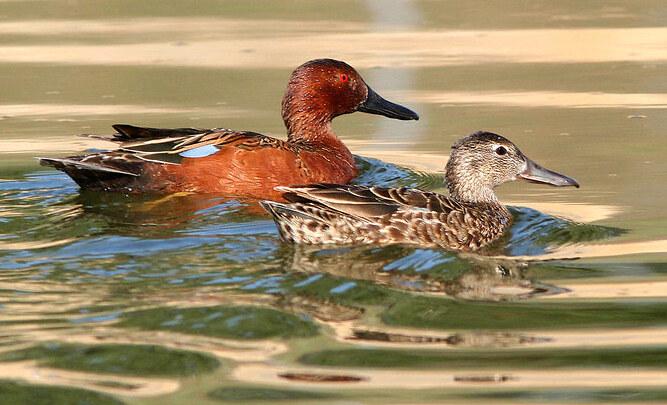Moderate
Cinnamon teal is a once fairly common breeding species in Washington that has declined significantly in the past 40 years. Breeding areas in eastern Washington have been affected by wetland succession, exotic and invasive vegetation such as loosestrife and Phragmites, development, hydroelectric dam impacts to freshwater wetlands, and intensive grazing in some areas.
Cinnamon teal is managed as a migratory game bird under state and federal migratory waterfowl regulations cooperatively through the Pacific Flyway Council.
Description and Range
Physical description
Cinnamon teal are about 16 inches in length and weight about 15 ounces. Males ("drakes") in breeding plumage have a bright rust colored head and underside; however, males molt in fall/winter into their basic non-breeding plumage ("eclipse") generally lasting until January or longer, so a pale blue forewing patch is the best field mark during that time period. Females ("hens") are a deeper brown color than blue-winged teal females.
The cinnamon teal male has a whistling peep; females utter a low quack.
For more information about how to identify this species, check out the Resources section.
Ecology and life history
Cinnamon teal breeding areas typically contain dense upland vegetation near freshwater ponds and lakes, usually with dense aquatic vegetation. Where preferred upland plant cover is poor, they are known to nest over water in emergent vegetation.
Cinnamon teal are primarily found in Washington during the breeding season, and one of the last dabbling ducks to arrive on the breeding areas in early May. The peak of nesting occurs in mid‐May to mid‐June.
Food habits of adults during the nesting season appear to be equally comprised of plant and animal food items. As the season progresses and fall migration grows closer, their food preference shifts toward plants.
Cinnamon teal depart Washington breeding areas for southern wintering areas in late summer, usually before most other dabbling duck species.
Geographic range
Of the three North American teal species, cinnamon teal are the least widely distributed, and much less is known of their population dynamics than blue‐ or green‐winged teal.
Cinnamon teal occur in Washington during the breeding season mainly in eastern Washington, in the Columbia Basin and channeled scablands. Cinnamon teal are rarely encountered in Washington during winter, and they migrate south as far as northern South America.
Recent WDFW aerial surveys indicate an average breeding population of approximately 7,000 in Washington during 2009 to 2014. Breeding Bird Survey estimates for cinnamon teal in Washington have declined significantly from 1968 to 2012 (-3.3 percent annually), and causes are unknown.
For maps of world-wide distribution and other species’ information, check out NatureServe Explorer and the International Union for Conservation of Nature Red List.
Climate vulnerability
Sensitivity to climate change
Moderate
Very limited information is available regarding sensitivity of cinnamon teal to climate change, particularly in Washington. Generally, their overall sensitivity is likely due to potential impacts on habitat availability and quality. Habitat factors such as amount of food and floods (i.e., spring floods and beavers) have been linked to breeding success. Declines in snowpack or altered flow regimes that affect these habitat factors could impact the number of teal broods. If this species exhibits low phenotypic plasticity in terms of timing of breeding (i.e., less able to track environmental change), climate warming could also affect its breeding success due to timing mismatch.
Exposure to climate change
Moderate
- Increased temperatures
- Reduced snowpack
- Altered hydrology
Regulations
Rules and seasons
For current rules about hunting cinnamon teal in the state, be sure to check the Washington Game Bird and Small Game hunting regulations.
Conservation
The cinnamon teal is managed as a migratory game bird under state and federal migratory waterfowl regulations cooperatively through the Pacific Flyway Council. The Pacific Flyway Council is an administrative body that forges cooperation among public wildlife agencies for the purpose of protecting and conserving migratory birds in western North America. The Council is composed of the director or an appointee from the public wildlife agency in each state and province in the western United States, Canada, and Mexico.
WDFW has various game management plans to track populations and harvest of games species around the state, including waterfowl. These plans have information about harvest statistics from recent years, and the department's long-term vision and goals for a variety of species.
In early 2003, WDFW formed the Washington Waterfowl Advisory Group (WAG) to increase citizen involvement in the conservation and management of Washington’s waterfowl resources. This group has members from a broad representation of waterfowl hunters throughout the state. To learn about the WAG, contact the WDFW Waterfowl Section at (360) 902-2515 or visit the WAG webpage.
Conservation Threats and Actions Needed
- Agriculture and aquaculture side effects
- Threat: Wetland losses and degradation due to irrigation management.
- Action Needed: Restore freshwater wetlands.
- Threat: Intensive grazing impacts on freshwater wetlands.
- Action Needed: Mitigate grazing impacts on nesting and brood cover.
- Fish and wildlife habitat loss or degradation.
- Threat: Wetland losses and degradation due to hydrologic impacts from development.
- Action Needed: Acquire important breeding habitat and manage nesting cover through prescribed grazing and other methods.
See the Climate vulnerability section for information about the threats posed by climate change to this species.
Resources
References
Gammonley, J. H. 2012. Cinnamon Teal (Anas cyanoptera), The Birds of North America Online (A. Poole, Ed.). Ithaca: Cornell Lab of Ornithology; Retrieved from the Birds of North America Online.
WDFW publications
Other resources
- U.S. Fish and Wildlife Service - Overview: Cinnamon Teal
- U.S. Fish and Wildlife Service - Aerial Observer’s Guide to North American Waterfowl
- U.S. Fish and Wildlife Service - Ducks at a Distance: A Waterfowl Identification Guide
- Cornell Lab All About Birds - Cinnamon Teal
- eBird Northwest – Cinnamon Teal


